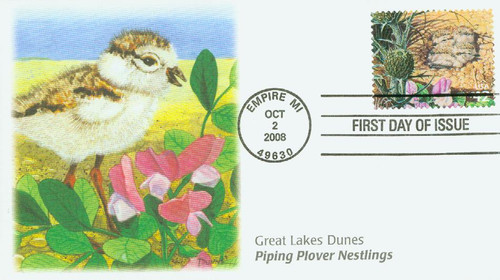
# 4352c - 2008 42c Gr. Lakes Dunes Piping Plover
U.S. #4352c
Piping Plover
Great Lakes Dunes
Nature of America Series
Issue Date: October 2, 2008
City: Empire, MI
Piping plovers, small, sparrow-sized birds, are recognizable by their sandy color. This coloring benefits as well as hurts these birds. Their coloring is dangerous to them, as humans often step on the birds or drive over them, since they are nearly invisible in the sand.
When hunting for insects and other food they stand still, blending in with the sand before striking. They often use the run-stop-scan technique by leaning toward the ground and pecking at the surface. Their “foot-tremble” method surprises their prey into movement so the plover can attack unexpectedly. These birds normally live, hunt, and migrate in small numbers.
Piping plovers are so named because of their unique call. When standing or flying, the bird’s call is a soft whistle. Their more frequently heard alarm call is a soft “pee-werp,” with the latter half of the call at a lower pitch. When males are attempting to court females, they repeat a high-pitched, sometimes drawn-out song up to 40 or more times per flight. The flights are usually made in the shape of a figure eight. When threatened, plovers are known for their aggressive behavior. Often, plovers bite, peck, or otherwise attack intruders in their territory.
U.S. #4352c
Piping Plover
Great Lakes Dunes
Nature of America Series
Issue Date: October 2, 2008
City: Empire, MI
Piping plovers, small, sparrow-sized birds, are recognizable by their sandy color. This coloring benefits as well as hurts these birds. Their coloring is dangerous to them, as humans often step on the birds or drive over them, since they are nearly invisible in the sand.
When hunting for insects and other food they stand still, blending in with the sand before striking. They often use the run-stop-scan technique by leaning toward the ground and pecking at the surface. Their “foot-tremble” method surprises their prey into movement so the plover can attack unexpectedly. These birds normally live, hunt, and migrate in small numbers.
Piping plovers are so named because of their unique call. When standing or flying, the bird’s call is a soft whistle. Their more frequently heard alarm call is a soft “pee-werp,” with the latter half of the call at a lower pitch. When males are attempting to court females, they repeat a high-pitched, sometimes drawn-out song up to 40 or more times per flight. The flights are usually made in the shape of a figure eight. When threatened, plovers are known for their aggressive behavior. Often, plovers bite, peck, or otherwise attack intruders in their territory.







